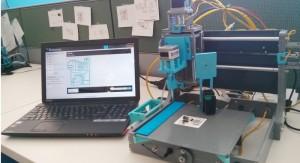 According to UrbanDictionary.com “squink” can mean a lot of things. It can mean the sound that is produced from a squeegee on a wet window, high grade amphetamine or even to obfuscate.
According to UrbanDictionary.com “squink” can mean a lot of things. It can mean the sound that is produced from a squeegee on a wet window, high grade amphetamine or even to obfuscate.
Whatever “squink” currently means to you, the guys at BotFactory want the word to become synonymous with affordable 3D-printed technology. That’s why the company has launched a new Kickstarter campaign featuring a product called Squink.
Squink is a specialized 3D printer that allows you to print your own circuit boards. Circuit boards are used in all electronic devices—from cell phones to computers. Squink was developed by a group of engineers who met at NYU Polytechnic School of Engineering. They began developing the printer 18 months ago when they entered a prototyping competition at the NYU Polytechnic School of Engineering.
Squink works by allowing users to print conductive “ink” onto a substrate to create what BotFactory calls silverboards. Next, conductive glue dots are placed on the silverboard where the pins of the components will be placed. Then the components are picked up from a tray, aligned, rotated and placed on the glue dots and the board is allowed to cure or dry.
The Squink printer connects to your computer’s via USB, Ethernet cable and Wifi. Once you’ve downloaded or created your own circuit design files, you upload them to the printer. The printer then walks you through the printing process.
Squink is useful because it solves a problem. It bridges the gap and makes circuity accessible to everyone—from the pro electronics designer and hobbyist, to the newbie. The printer can create plug and play circuit boards in about 30 minutes. Usually, if you want to create your own electronics, you have to have access to pre-printed circuit boards, which can be expensive.
Though some may be tempted to ditch traditional circuit boards altogether thanks to this innovation, Squink’s developers don’t want it to totally replace the current process of sending projects to manufacturers to build. Instead they want the printer to be a tool for people to test out their ideas immediately.
“We really want to be a stepping stone — try it out really quickly and once you’re ready, then you crank out about 100 boards from a manufacturer,” Nicholas Vansnick, the team’s robotics engineer told TechCrunch.
It’s pricey upfront ($2,999) to buy a Squink, but the money is going to a good cause–BotFactory will use the money it raises on Kickstarter to create a community where people can share circuit schematics, redesign the printer to make it more functional and user-friendly and mass-manufacture it. Have you backed this Kickstarter project? What do you think about this idea for a circuit board printer? Let us know in the Squink forum thread on 3DPB.com.
Subscribe to Our Email Newsletter
Stay up-to-date on all the latest news from the 3D printing industry and receive information and offers from third party vendors.
You May Also Like
Precision at the Microscale: UK Researchers Advance Medical Devices with BMF’s 3D Printing Tech
University of Nottingham researchers are using Boston Micro Fabrication‘s (BMF) 3D printing technology to develop medical devices that improve compatibility with human tissue. Funded by a UK grant, this project...
3D Printing Webinar and Event Roundup: April 21, 2024
It’s another busy week of webinars and events, starting with Hannover Messe in Germany and continuing with Metalcasting Congress, Chinaplas, TechBlick’s Innovation Festival, and more. Stratasys continues its advanced training...
3D Printing Webinar and Event Roundup: March 17, 2024
It’s another busy week of webinars and events, including SALMED 2024 and AM Forum in Berlin. Stratasys continues its in-person training and is offering two webinars, ASTM is holding a...
3D Printed Micro Antenna is 15% Smaller and 6X Lighter
Horizon Microtechnologies has achieved success in creating a high-frequency D-Band horn antenna through micro 3D printing. However, this achievement did not rely solely on 3D printing; it involved a combination...































